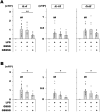Glutathione trisulfide prevents lipopolysaccharide-induced retinal inflammation via inhibition of proinflammatory cytokine production in glial cells
- PMID: 37460786
- PMCID: PMC10352383
- DOI: 10.1038/s41598-023-38696-4
Glutathione trisulfide prevents lipopolysaccharide-induced retinal inflammation via inhibition of proinflammatory cytokine production in glial cells
Abstract
We aimed to investigate the impact of glutathione trisulfide (GSSSG) on lipopolysaccharide (LPS)-induced inflammation in retinal glia. Inflammatory responses in mouse-derived glial cells and Wistar rat retinas were stimulated with administration of LPS. Cell survival and proinflammatory cytokine production were examined using the Calcein-AM assay, and reverse transcription-quantitative polymerase chain reaction (RT-qPCR) and enzyme-linked immunosorbent assay (ELISA), respectively. Retinal microglia were visualized with immunohistochemistry for Iba1. Administration of LPS (10 µg/mL) or GSSSG (less than 100 µM) did not affect survival of cultured primary Müller cells and established microglial cells (BV-2). RT-qPCR and ELISA indicated that GSSSG inhibited LPS-induced gene upregulation and protein secretion of proinflammatory cytokines in these glial cells and rat retinas. GSSSG inhibited LPS-induced activation of TGF-β-activated kinase 1 (TAK1), which is an upstream kinase of NF-κB, in BV-2 cells. Finally, in vivo experiments indicated that intravitreal administration of GSSSG but not its relative glutathione disulfide (GSSG) inhibited LPS (500 ng)-induced accumulation of Iba1-immunopositive microglia in rat retinas. Taken together, GSSSG has the potential to prevent pathogenesis of inflammation-associated ocular diseases by inhibiting proinflammatory cytokine expression in retinal glial cells.
© 2023. The Author(s).
Conflict of interest statement
The authors declare no competing interests.
Figures






Similar articles
-
Glutathione Trisulfide Prevents Lipopolysaccharide-induced Inflammatory Gene Expression in Retinal Pigment Epithelial Cells.Ocul Immunol Inflamm. 2022 May 19;30(4):789-800. doi: 10.1080/09273948.2020.1833224. Epub 2020 Nov 20. Ocul Immunol Inflamm. 2022. PMID: 33215957
-
Lithium Chloride Exerts Anti-Inflammatory and Neuroprotective Effects by Inhibiting Microglial Activation in LPS-Induced Retinal Injury.Invest Ophthalmol Vis Sci. 2023 Mar 1;64(3):35. doi: 10.1167/iovs.64.3.35. Invest Ophthalmol Vis Sci. 2023. PMID: 37000125 Free PMC article.
-
Gastrodin inhibits expression of inducible NO synthase, cyclooxygenase-2 and proinflammatory cytokines in cultured LPS-stimulated microglia via MAPK pathways.PLoS One. 2011;6(7):e21891. doi: 10.1371/journal.pone.0021891. Epub 2011 Jul 12. PLoS One. 2011. PMID: 21765922 Free PMC article.
-
Tetramethylpyrazine attenuates endotoxin-induced retinal inflammation by inhibiting microglial activation via the TLR4/NF-κB signalling pathway.Biomed Pharmacother. 2020 Aug;128:110273. doi: 10.1016/j.biopha.2020.110273. Epub 2020 May 24. Biomed Pharmacother. 2020. PMID: 32460188
-
Resveratrol inhibits inflammatory responses via the mammalian target of rapamycin signaling pathway in cultured LPS-stimulated microglial cells.PLoS One. 2012;7(2):e32195. doi: 10.1371/journal.pone.0032195. Epub 2012 Feb 21. PLoS One. 2012. PMID: 22363816 Free PMC article.
Cited by
-
Metabolic reprogramming in sepsis-associated acute kidney injury: insights from lipopolysaccharide-induced oxidative stress and amino acid dysregulation.Mol Biol Rep. 2024 Dec 16;52(1):52. doi: 10.1007/s11033-024-10175-7. Mol Biol Rep. 2024. PMID: 39680269
-
Supersulfides: A Promising Therapeutic Approach for Autoinflammatory Diseases.Microbiol Immunol. 2025 Apr;69(4):191-202. doi: 10.1111/1348-0421.13205. Epub 2025 Feb 16. Microbiol Immunol. 2025. PMID: 39956868 Free PMC article. Review.
-
The Therapeutic Potential of Supersulfides in Oxidative Stress-Related Diseases.Biomolecules. 2025 Jan 23;15(2):172. doi: 10.3390/biom15020172. Biomolecules. 2025. PMID: 40001475 Free PMC article. Review.
-
Supersulfide donors and their therapeutic targets in inflammatory diseases.Front Immunol. 2025 Apr 16;16:1581385. doi: 10.3389/fimmu.2025.1581385. eCollection 2025. Front Immunol. 2025. PMID: 40308575 Free PMC article. Review.
-
Supersulfide formation in the sinus mucosa of chronic rhinosinusitis.Laryngoscope Investig Otolaryngol. 2024 Jul 27;9(4):e1261. doi: 10.1002/lio2.1261. eCollection 2024 Aug. Laryngoscope Investig Otolaryngol. 2024. PMID: 39071205 Free PMC article.
References
-
- Le J, Vilcek J. Interleukin 6: A multifunctional cytokine regulating immune reactions and the acute phase protein response. Lab. Invest. 1989;61:588–602. - PubMed
Publication types
MeSH terms
Substances
LinkOut - more resources
Full Text Sources
Miscellaneous

